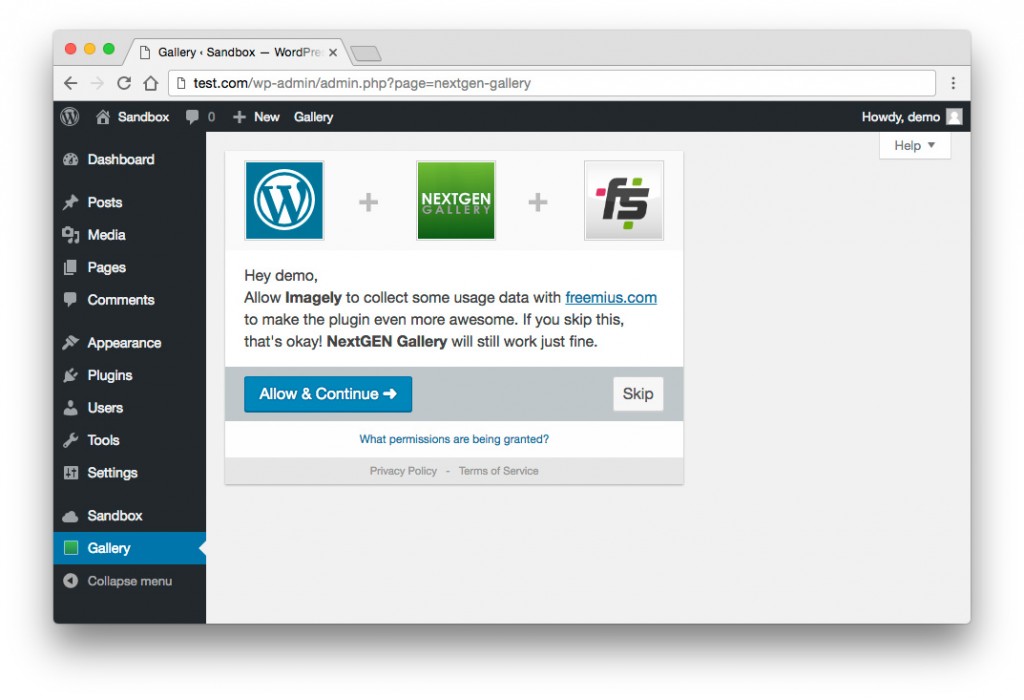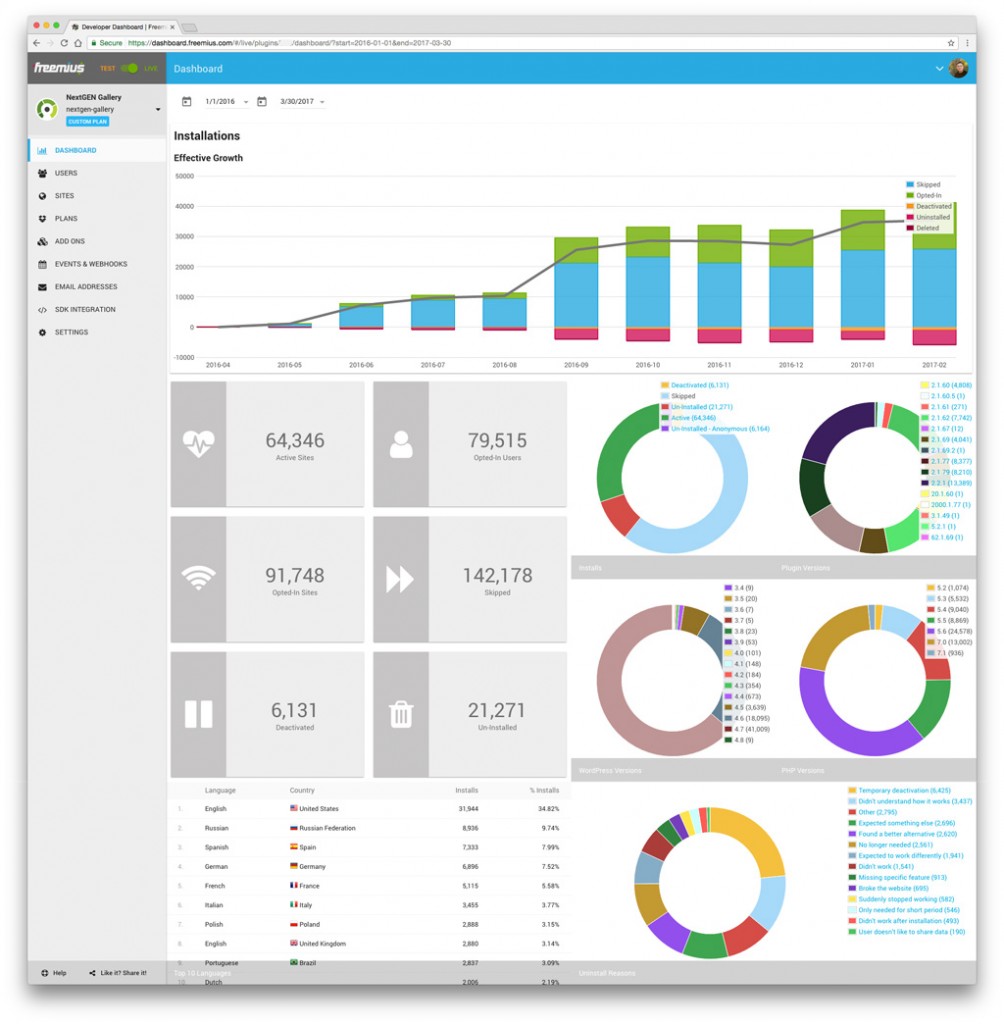This time I want to bring forth a special success story of the very popular WordPress plugin: NextGEN Gallery, by Imagely. In fact, it’s our most popular plugin maker here at Freemius.
After working with various high-caliber makers, one of the things that we’ve learned is that usage-tracking and lead generation can become quite pricey very quickly, mainly due to the large amounts of data. If the company doesn’t allocate/have the human resources and time to invest in taking those leads and data and convert them into revenue that’s prone to tumble the process. Increasing your bottom line involves analyzing and taking action on the insights extracted from your product.
Therefore, we changed our strategy, and when we work with successful plugin or theme businesses, such as Imagely, we offer a combination of the platform with a services layer. In the combo, we take the time to build a marketing automation campaign, based on the maker’s needs, in order to convert the data into dollars. NextGEN Gallery was the first plugin we’ve partnered with in such a constellation, and we are super-happy with the results!
I’ve therefore invited Imagely’s founder and CEO, Erick Danzer, to answer a few questions and share his perspective on the partnership. He’ll also be sharing with you some of the most interesting insights they’ve come across since integrating the popular NextGEN Gallery plugin with Freemius Insights to better their plugin and get to know their users.
Erick, thanks for agreeing to do this! Why don’t we start off by getting to know you a bit – where are you based and how did you get into the business you’re in?
Thanks, Vova! Imagely is based in beautiful Boulder, Colorado. That’s where I happen to be. But our team is completely remote, spread out across the United States, Canada, and Europe.
I always planned to start a business. My grandfather was one of the early franchisees in the McDonald’s system. He started the 128th franchise, the first in St. Louis. He then later started one of the first in Florida. I used to talk business with him growing up. A lot of the rest of my family is entrepreneurial as well.
I also have a long interest in and passion for photography. It’s something I’ve done since high school.
All that said, for the decade prior to starting Imagely, I was in a different field. I did a Ph.D. in Asian politics and worked at the State Department. During my graduate school career, I lived in Indonesia for a couple of years and took a year off to work as a freelance photographer and videographer. I did a lot of interesting projects and developed an empathy for the challenges of making a living as a photographer.

In 2009, my wife and I took a leap and made a number of life decisions all at once. We moved from Washington DC to Boulder, and I started our business. Initially, it was an online magazine for photographers. But those were the early days of WordPress, and at that time there were limited WordPress options for photographers. We launched the Photocrati theme as our first product in 2009, and that took off. We later acquired NextGEN Gallery and then launched a range of other products in the same image-centric space.
Could you give us an idea of what Imagely is all about and what you’re focused on, as a company?
The largest part of our business right now is NextGEN Gallery. It continues to be one of the most popular plugins on the WordPress.org repo, and it represents nearly 2/3rds of our revenue.
In 2016, we re-launched our business as Imagely and folded NextGEN Gallery into that brand. Imagely’s goal is simple: to become the default solution for photographers on WordPress.
Right now, most photographers have WordPress blogs. But they also maintain non-WordPress websites for their galleries, and particularly for client proofing and print sales. This means photographers almost always run more than one website. The non-WordPress companies – SmugMug, PhotoShelter, ShootProof, Zenfolio, Pixieset, and others – are much larger on average than most WordPress companies, including ours.
Imagely’s goal is simple: to become the default solution for photographers on WordPress.
We aim to help photographers simplify their work by consolidating onto a single platform, WordPress. To do this, we offer a hosted WordPress solution that makes it very easy to launch and maintain a WordPress website. That’s the focus of our hosted solution.
We also need to ensure photographers can do everything on WordPress that they can do on a non-WordPress platform. For example, photographers live and breath Adobe Lightroom. We’ve recently released a new Lightroom plugin that allows photographers to upload and manage their NextGEN Galleries directly from Lightroom.
The most important feature missing from WordPress is print lab integration or automated print fulfillment. This is the bread-and-butter of most non-WordPress website solutions. As of now, it’s not possible on WordPress at all. The remote and distributed nature of WordPress installations makes it hard to develop.
Print lab integration is our single biggest priority, and we’re hoping to launch it this year. We believe that bringing print lab integration to WordPress has the potential to shake up the photo industry and to shift the beating heart of most photographer websites – their galleries – from non-WordPress platforms to WordPress.

How many employees are there at Imagely at the moment? Are you guys all working from an office?
We’re a team of 11 spread out across the United States, Canada, and Europe. I think that total will grow to 15-20 people by the end of 2018. We don’t maintain a central office, and I’d like to keep it that way as long as we can.
The NextGEN Gallery Plugin
What makes the NextGEN Gallery plugin by Imagely special when compared with other image plugins for WordPress?
I think the answer has two parts.
First, NextGEN is an image management tool in a way almost no other plugin is. Most gallery plugins are ‘display plugins.’ They allow you to take some images from the media library and display them in a particular way. That’s great, but it’s also limited. By contrast, NextGEN allows you to efficiently upload, organize, reorganize, bulk edit, and bulk-manage thousands of images in a way that’s very familiar to photographers.
The second big difference is just a sheer volume of options. NextGEN is immensely powerful, with thousands of options. Indeed, a common point that some make, including competitors, is that NextGEN has too many options and is, therefore, complex. Most competing plugins intentionally position themselves simpler solutions. We’re fine with that, and we know simple solutions are fine for many users. But that’s not our goal. Our goal is to have the most powerful image and gallery plugin, period.
Why do you think the NextGEN Gallery plugin became SO popular?
You know, I think that what made NextGEN popular and what keeps it popular are different. NextGEN initially became popular because it was one of the first great gallery plugins, built when the media library was very limited. So if you wanted galleries at all in 2008, you probably opted for NextGEN Gallery.
Since then, the media library has gotten better and many new, simple gallery plugins have emerged. What keeps NextGEN Gallery popular now are the comparative advantages I mentioned above – it is the most powerful solution in its space, and it is perhaps the only true image management tool (vs a display plugin).
NextGEN Gallery & Freemius
It took me over a year to convince you to try out Freemius with NextGEN Gallery. Can you remember what were your main concerns about the platform, prior to getting started?
Haha, yes, it sure did. I admire your persistence.
We had two big initial concerns I think. First, there were just some general concerns about what felt like inserting a third party into the normal interaction between us and our user base. As anyone who manages big popular WordPress plugins can attest, you need to be very delicate with that. Second, and perhaps a subset of that, we knew that the starting point of the process was to start showing an opt-in form to users when they activate the plugin. That’s not yet a normal part of the WordPress plugin experience, and we had concerns about potential backlash.

I’ll talk about these both more, but the short story is that the subsequent experience has shown both of these concerns to be unfounded. We now show the opt-in to 100% of new installations, and we’ve probably added close to 100,000 emails to our list so far. To date, we’ve seen almost no negative feedback or reaction from our users.
What were the reasons that eventually made you decide to get onboard?
For us, I have to say it was mostly emails. Building on WordPress has huge advantages in terms of being able to reach a lot of people easily. But on the downside, the fact that free themes and plugins are downloaded from a third party site (the WP.org repository) creates a unique challenge. Most theme and plugin makers have almost no way to communicate with most of their free users. From the perspective of most normal businesses, that’s a crazy situation.
We really wanted to overcome that and get to a point where we could communicate more reliably with our community. That meant showing an opt-in form and capturing emails.
We could have coded this up ourselves, but Freemius offered a well-tested and well-optimized out-of-the-box solution. And beyond that, it offered a lot more data than we could get from doing the email part ourselves. That data has been useful.
From the perspective of normal businesses, the fact that WordPress theme and plugin makers have almost no way to communicate with their free users is a crazy situation.
I should add that we set up a custom arrangement with you to help set up and optimize some initial emails. So we leveraged your team to get some other important parts of our email communication channel in place as well.
How long did it take to integrate Freemius into NextGEN Gallery and start gaining insights with it?
Initial setup was obviously quite quick. I think if we just wanted to add it and launch, we could have done so in days. We aggressively test all changes we make, no matter how small, in a variety of conditions. Our normal testing probably would have taken more time than the initial integration.
In our case, because of some of the concerns I mentioned above, we also decided to roll Freemius out slowly to test the water. We set it initially so that only 10% of new installs would see the opt in form. We left it like that for months to check the reaction. When we were sure there wasn’t going to be any negative feedback, we then incrementally bumped the percentage up. I think it probably took close to 6 months to get to 100% of new installs.
While this cautionary approach took us longer, it allowed us to roll things out smoothly and safely.
What have you discovered with the data collected with Freemius?
We’ve learned quite a bit. I’ll just review a few interesting and representative data points and conclusions.
Since we started with Freemius, we’ve exposed the Freemius/NextGEN opt-in form to about 220,000 NextGEN users, using a customized, non-aggressive opt-in prompt. These are all people who are newly activating the plugin, not existing users. Of those, about 37.5% have opted in to help give us data, while the remainder skipped. That gives us about 80,000 users from whom we can see aggregate data.

We’ve learned that 21% of users deactivate or uninstall the plugin entirely. Conversely, that means we have about a 79% retention rate. It’s hard to know how that compares to the WordPress ecosystem as a whole, but our sense is that nearly 80% retention is not bad.
Of those who uninstall, about 20% (the largest share) do so because they “don’t understand how it works.” This wasn’t too much of a surprise. We know that NextGEN Gallery is powerful with a lot of options and that some users can feel overwhelmed. But this is the first time we’ve been able to put actual numbers on that behavior.
Have there been any improvements made to the plugin as a direct result of the data you’ve gathered?
Sure. I think the big improvements that we’ve pursued as a result are interface improvements.
We now know that 21% of users uninstall and that the biggest reason is complexity getting started. That tells us that if we want to improve our retention rate, we need to make it easier to start.
To that end, we’ve done two things. First, we released a start-up Gallery Wizard late last fall that walks new users through the process of setting up their first gallery. Second, we’re about 70% done with a complete overhaul of the interface to simplify the presentation of options.
These are both things we probably would have done anyways, but we upped their priority based on Freemius data.
How would you describe your experience working in cooperation with the Freemius team towards improving NextGEN Gallery and optimizing user retention while decreasing churn?
Your team has been great. I’ve been amazed at the amount of progress you keep making on the Freemius platform. You’ve also been particularly attentive to our concerns, including customizing a solution for us to get us on board in the first place. I’ll add that Vova has become a trusted colleague with whom I discuss things well beyond the scope of our Freemius integration.
What is the thing you like most about Freemius?
I noted above that gathering more emails and communicating more reliably with our free user base was our biggest initial motivation. Not surprisingly then, I’d say our success in gathering emails has been the biggest benefit for us. We’ve now collected nearly 80,000 emails from free users. That allows us to circulate updates and otherwise keep people informed. Being able to see honest, real data about deactivate rates, uninstall rates, and other light usage data has also been a big deal, giving us the most precise understanding of our user dynamics we’ve ever had.
We’ve now collected nearly 80k emails from free users. That allows us to circulate updates and otherwise keep people informed.
Final Thoughts
Where do you see Imagely in 5 years from today?
In five years, Imagely will be one of the dominant website solution providers for photographers. If you’re in a room full of photographers and you ask them how they run their websites, most of them will say Imagely. Indeed, Imagely will be so pervasive that many of them won’t even distinguish between WordPress and Imagely – they just know Imagely is WordPress for photographers.
What’s one good tip you can provide for developers who are looking to create a sustainable business around WordPress plugins or themes?
Two words: recurring revenue. Historically, so many WordPress companies have just sold a theme or plugin to a user for a one-time price. Whether you offer one year of updates or lifetime, the fact is you’re going to get very little repeat business. And sustainable business is built on repeat business. Without it, you don’t have a business. So whatever you do, make sure you have a clear mechanism to get repeat revenue from your customer base.
That sounds familiar…
I should add that Freemius offers a great solution to that problem for theme and plugin developers who sell via the Freemius platform.
Is there any other product by Imagely you’d like to plug? We’re always happy to hear about exciting new projects!
We always have so much going on. Even Imagely itself – including the hosting solution and new series of Genesis WordPress themes – is only a year old. We have a complete redesign of the NextGEN interface coming out in 2017, and we’ve pushed multiple new display types, new template mechanism, and other features all in the last few months. But we’re particularly happy right now with our new Lightroom plugin. There are few of these floating around, including one from Automattic, but ours is better :). Beyond that, I’d tell everyone to look out for print lab integration, which is going to be epic.
Erick, thank you very much for agreeing to answer my questions, and for being so cooperative and open about the success of combining NextGEN Gallery & Freemius. I think that both teams gained a lot from working together towards being more data-driven when iterating on our WordPress products.
Appreciate you!








I've been using this plugin for some time on some of my older websites, I remember not being able to update due to an overhaul of it but apart from that it's served me well..